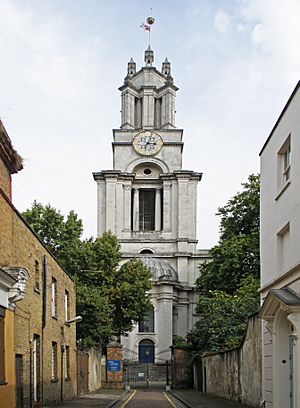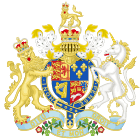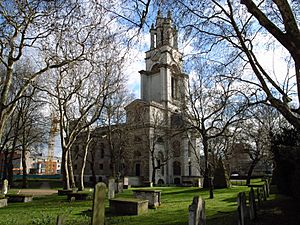St Anne's Limehouse facts for kids
Quick facts for kids St Anne's Limehouse |
|
|---|---|
 |
|
| Denomination | Church of England |
| Churchmanship | Conservative Evangelical |
| Architecture | |
| Heritage designation | Grade I listed |
| Administration | |
| Parish | Limehouse |
| Deanery | Tower Hamlets Deanery |
| Diocese | London |
| Province | Canterbury |
St Anne's Limehouse is a special Anglican Church in Limehouse, London. It was designed by a famous architect named Nicholas Hawksmoor. This church was officially opened in 1730. It was one of twelve churches built because of a law passed in 1711. This law aimed to build many new churches for London's growing population.
Contents
The Story of St Anne's Church
| Limehouse Parish Act 1729 | |
|---|---|
| Act of Parliament | |

|
|
| Long title | An Act for making the Hamlet of Limehouse, and Part of the Hamlet of Ratchiffe, in the Parish of St. Dunstan, Stebonheath, alias Stepney, in the County of Middlesex, a distinct Parish; and for providing a Maintenance for the Minister of the new Church there. |
| Citation | 3 Geo. 2. c. 17 |
| Territorial extent | Great Britain |
| Dates | |
| Royal assent | 15 May 1730 |
| Commencement | 13 January 1730 |
| Other legislation | |
| Repealed by | London Government (Borough of Deptford) Order in Council 1901 |
|
Status: Repealed
|
|
| Text of statute as originally enacted | |
St Anne's Limehouse was created by a law called the Limehouse Parish Act 1729. This law took a piece of land from the large St Dunstan's, Stepney area. In the 1700s, London's population grew very fast. Because of this, older, bigger church areas, called parishes, were divided into smaller ones. In 1709, a new parish in Limehouse was formed. The church might have been named after Queen Anne. She helped raise money for it by taxing coal that came along the Thames River.
Building the Church
The church was designed by Nicholas Hawksmoor. He was a very important architect. St Anne's was one of twelve churches built to help the many new people living in London. These churches were sometimes called the Queen Anne Churches. The building was finished in 1727 and officially opened in 1730. It was built by Edward Strong the Younger. He was a friend of Christopher Wren the Younger.
A Special Flag and Landmark
Queen Anne decided that St Anne's Church would be a good place for sea captains to record important events that happened at sea. This was because the church was so close to the river. So, she gave St Anne's Church a special right. It could fly the White Ensign, which is a very important flag of the Royal Navy.
The church's tall tower has a golden ball on its flagpole. This made it a "sea mark" on maps for sailors. It helped ships find their way. Even today, St Anne's Limehouse is allowed to fly the White Ensign all day, every day.
Fires and Fixes
In 1850, a big fire badly damaged the church. It was fixed between 1851 and 1854 by Philip Hardwick. Later, between 1983 and 1993, Julian Harrap restored it again. During this time, strong steel supports were added to the roof.
In 1950, the church was given a special status. It became a Grade I listed building. This means it is a very important historical building. More repairs happened between 2007 and 2009. The organ, altar, and floor were all fixed up.
The Church Organ
The first pipe organ was built in 1741. But it was destroyed in the 1850 fire. The organ that replaced it was built by Gray and Davison. It even won first prize at the Great Exhibition of 1851. Musicians today still love this organ.
Since 2009, the church has been the main practice place for the Docklands Sinfonia. This is a music group. The church also sometimes holds classical music concerts. Today, St Anne's is still the main church for the Limehouse area. It is part of the Diocese of London.
The Churchyard Gardens
After people stopped being buried in the churchyard, it was turned into public gardens. The Metropolitan Public Gardens Association helped with this. A landscape gardener named Fanny Wilkinson designed the garden. She kept a special stone pyramid built by Hawksmoor in 1730. It has the words "The wisdom of Solomon" carved on it. There is also a white stone war memorial from 1918 in the churchyard. It has a bronze figure of Christ. Both the pyramid and the memorial are also listed as important historical items.
St Anne's Today
St Anne's is part of the Conservative Evangelical group within the Church of England. It describes itself as "A genuinely mixed East End Church with a passion for straightforward Bible teaching." This means they focus on teaching directly from the Bible.
Where to Find St Anne's
The church is right next to Limehouse Town Hall. It is also close to Limehouse Library. Both of these buildings are also important historical sites. Across the road is the old Sailors' Mission.
The address for the church is: St Anne's Church, Three Colt Street, London E14 7HP. The closest train station is Westferry. You can get there using the Docklands Light Railway.
St Peter's Barge: A Church on Water
In the late 1900s, the East London Docklands area was rebuilt. More than 100,000 people now work in the Canary Wharf area. A big part of this business center is in St Anne's church area. So, St Anne's started holding meetings during lunchtime in pubs and cafes. They wanted to reach out to people working in Canary Wharf.
This idea grew with help from St Helen's Bishopsgate church. But it was hard to find a permanent place in Canary Wharf because land there is very expensive.
The Idea of a Floating Church
The idea of a floating church came true when the St Peter's Canary Wharf Trust was formed. In 2003, they bought a Dutch freight barge. This barge was fixed up in the Netherlands. Then, it sailed across the North Sea by itself in the summer of 2003. A BBC documentary even showed this journey.
Now, the barge has a permanent spot in the West India Quay area. It is right in the middle of everything. In July 2004, a full-time Church of England minister was chosen to lead the church on the barge. In September 2004, St Peter's started a new Sunday evening church service. It also has groups and meetings for the many thousands of people who now live in the area.
See also


